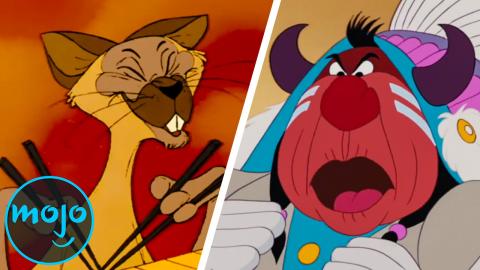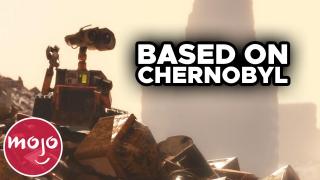Creepiest Facts About Disney Movies that Will Ruin Your Childhood

Facts About Disney Movies that Will Ruin Your Childhood
Top 10 Kids' Movie Facts That Will Ruin Your Childhood
Now that you’re all grown up, you may see these things a little differently. Welcome to WatchMojo and today we’re looking at Facts about Disney Movies that Will Ruin Your Childhood. For this essay, we’re going to be looking at both behind the scenes facts and story elements in Disney’s animated films. Disney movies are primarily made to be enjoyed by children, but they often clearly have an adult audience in mind as well. While some of these jokes and references may have gone right over your head when you were a kid, as you’ve gotten older you’ve probably noticed some quite suggestive jokes in favorite childhood movies. They’re usually subtle but once you notice them, you can’t unsee them. Just look at Buzz’s wings springing to attention in “Toy Story 2”; or the scene in which two girls “flash” their idol in “Cars”; and that foot size joke in “Frozen”. There are also persistent rumors that pranksters have worked more explicit sexual messages into Disney animations. In the mid 90s, conservative Christian groups raged against “The Lion King” over a scene in which a dust cloud appears to form the word “sex”. One of the film’s animators later claimed it spelt “SFX” - for “special effects”. Another popular claim is that the eponymous hero in “Aladdin” whispers “Good tenagers take off their clothes” to Rajah. While this seems pretty dubious, it turns out that at least some examples of production trickery really did take place. In 1999, a version of “The Rescuers” released for home video was quickly recalled when viewers discovered that when they freeze framed one scene, they could see an image of a topless woman in an open window. No one knows who inserted this picture, but it’s infamy lives on in Disney history. Disney bases many of their movies on historical stories and classic fairy tales. But they also take considerable liberties with their source material - omitting disturbing real life details, or darker plot points, that forever color the movies when we learn about them later on. Sometimes, the more you learn, the more you wish you could forget. The Hans Christian Andersen tale “The Little Mermaid”, for example, ends not with a happily-ever-after, but with the prince marrying someone else, and the mermaid’s sisters telling her to murder him so she can return to the ocean. Happily, she doesn’t . . . unhappily, she lets herself die instead, and becomes sea foam. Now that’s dark. The real life story of Pocahontas goes a little differently too. According to historians, John Smith’s claim that Pocahontas saved him from her father should be taken with a grain of salt; he also told a similar tale about a girl in Hungary. There’s no evidence that the two had a romantic relationship, which is for the best since when they met, Pocahontas was ten or twelve! She DID end up marrying a John, a tobacco planter called John Rolfe, with whom she had a child, and travelled to England . . . but she then died of illness at around 21 year old. Sometimes, it’s the backstory behind the creation of the films that takes away from the magic - as is the case with “Winnie the Pooh”. It turns out that the real life Christopher Robin, the son of series author A. A. Milne, was resentful of the fantastical stories written about him and had a strained relationship with his father. Even “The Lion King”, an original tale, is disturbing when you think about it in a real life context. Of course, it’s only original provided you discount all the similarities to “Kimba the White Lion”. Either way, it’s best not to dwell on the fact that Simba and Nala are most likely half-siblings, since Mufasa seems to be the only male lion in the pride. Alternatively, Nala’s father could be Scar, but that would still make them cousins. Fortunately, Disney made Pocahontas older for her on-screen romance with John Smith. But the official ages that Disney provides for their other princesses still raise a lot of questions. Snow White is supposed to be just 14 when she’s sent off into the woods to be murdered, making the whole tale feel much darker. Ariel is 16 when she ties the knot and shacks up with Prince Eric, and Belle is just a year older when she’s locked up and falls in love with her part-man part-animal captor. At least since Jasmine is 15, her rebellious attitudes makes a lot of sense. . . . but it sure makes the scene in which she distracts Jafar pretty uncomfortable. Disney dads are often important characters, even when their main role is just to marry off their very young daughters. Disney moms on the other hand are frequently nowhere to be found. In fact, you’ve probably noticed that a lot of Disney protagonists are either motherless, or orphaned, forcing them to forge their own paths in life without much parental intervention. While you may have assumed that this was just a convenient or traditional plot device, Walt Disney’s own personal life might have something to do with it too. In 1938, Walt Disney had already become quite successful, and wanted to help his aging parents out by purchasing a house for them. He had some studio employees work on fixing the broken furnace, but it turned out that the problem wasn’t correctly resolved. Not long after, Walt’s mother, Flora Disney, died from asphyxiation because of the fumes. Some have said that Walt blamed himself for the terrible accident, and went on to write more and more characters who didn’t have mothers. Now onto another biggie: racism and racist stereotypes. Man-behind-the-mouse Walt Disney has both defenders and detractors when it comes to accusations of racism and anti-semitism. On one hand, he donated to Jewish charities, and some of his Jewish employees have come to his defence. On the other, he was a founding member of an anti-communist organization with a reputation for anti-semitism, and hosted Nazi filmmaker Leni Riefenstahl during promotion of her movie before the outbreak of the second world war. Whatever you think about the man himself, it’s clear that racist stereotypes made their way into some of our most beloved Disney movies. Of course, some historical context is important, as many of these stereotypes were widespread stock characters; then again, that doesn’t exactly make us feel good about them either. One of the most glaring examples is the big bad wolf’s Jewish peddler disguise in “Three Little Pigs”. Then there are the Native American stereotypes in “Peter Man”. Today, the song “What Makes The Red Man Red” is pretty hard to listen to without cringing. The crows in “Dumbo” are also commonly cited as racist caricatures. But the most infamous example is undoubtedly the live-action/animated musical “Song of the South”, which has essentially been disavowed by many Disney fans. Honestly, we do love our Disney movies. But sometimes ignorance really is bliss. You’re welcome!


